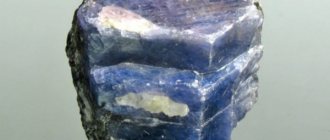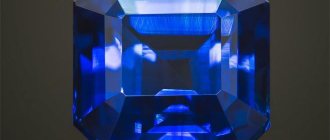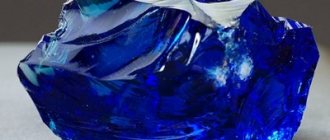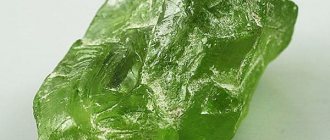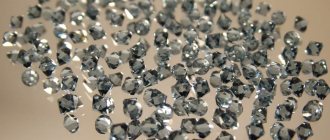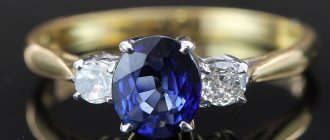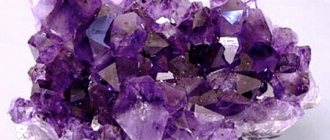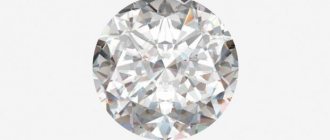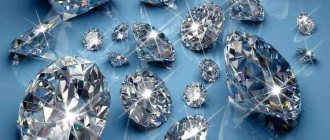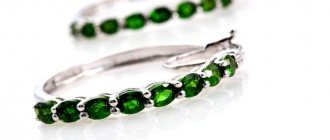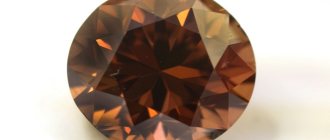The sapphire gemstone, in its chemical composition, belongs to aluminum oxides; gemologists call this mineral corundum. The peculiarities of its crystal lattice and maturation are such that it is not so common to come across natural corundum of jewelry quality. In nature, this layered substance, covered with small cracks, is usually found translucent, lacking the rich hue for which sapphires are highly valued. Another problem that jewelers face is the uneven concentration of impurities. And various contaminants accumulate in natural cracks. To improve the quality of the stone and give it jewelry value, craftsmen use various techniques, the purpose of which is to refine the sapphire.
Value criteria
The quality of an unheated sapphire is determined by four criteria: carat weight, clarity, color and cutting method.
1. The cost mainly depends on the weight. Each carat adds up to 20-50% to the price.
2. Purity is determined by the number of inclusions. Stones can be transparent or have a matte surface that allows almost no light to pass through. Although it is opaque minerals that acquire amazing properties after cutting: a star with two or more rays appears on their surface. This star sapphire is rated even higher than minerals with a high degree of purity.
Impregnation and diffusion
To improve shades, give greater depth and saturation, technologies have now been developed for impregnation with beryllium and introducing iron and vanadium ions into the mineral. The first method is more often called impregnation, the second - diffuse processing.
Beryllium is commonly used to improve the color of pinkish and yellowish stones. After processing, they acquire a rich yellow or orange tint. Moreover, if the mineral is no more than 3 mm, then beryllium will completely saturate it. It is not yet possible to completely change the color of large sapphires; there will still be an unpainted area in the center.
The diffusion processing method is used to give faintly colored blue corundums greater depth and color saturation. The essence of this method is that iron and vanadium atoms affect the ability of the crystal lattice to transmit the visible spectrum of radiation. This treatment also does not affect the central areas and is easily determined at high magnification.
Despite the fact that any methods of changing the color of sapphires do not affect their properties and, in general, do not significantly change the stone, international rules require that the certificate indicate which of the two methods the mineral was processed.
Methods for increasing the jewelry quality of sapphires are irreversible. They do not lose the color obtained during processing; the materials with which the cracks were filled will remain in the stone forever. Treated minerals do not require special care.
How sapphire is refined
People have long learned to turn ordinary-looking stones into beautiful jewelry. Heat treatment makes the stone darker or lighter. At the same time, the color is evened out, acquiring saturation and brightness.
Traces of processing are not easy to see. The price of a beautiful stone increases significantly. True, if at the time of sale it turns out that the mineral received a brilliant appearance through heat treatment, its value drops sharply.
Only specialists from gemological laboratories can accurately determine the actions performed on the stone. Therefore, we recommend purchasing sapphire jewelry from a manufacturer that has a proven track record in manufacturing precious items.
The St. Petersburg Art-Neva jewelry workshop accepts orders for the design and creation of jewelry from natural, unheated blue sapphire.
Jewelry from the Art-Neva collection
Ring with sapphire from the Art-Neva collection (see catalog)
Gold pendant with sapphire and diamonds, Art-Neva collection (see catalog)
Engagement ring with sapphire and diamonds, Art-Neva collection (see catalog)
Exclusive gold earrings with jade, sapphires and diamonds, Art-Neva collection (see catalog)
More about modern refining of rubies and sapphires.
Based on publications by one of the modern pillars of gemology, Professor Hanni, Switzerland Hanni HA SSEF Swiss Gemmological Institute, Basel, Switzerland Modern refining of precious rubies and sapphires In deposits of natural rubies and sapphires you can find stones of not only exceptional quality. High quality stone is rare, and there is a need to refine the medium and low quality raw materials that make up the majority of the volume mined. When we talk about improving quality, we must first define what quality means. Important indicators of the quality of a stone include its size, weight, color, transparency and resistance to mechanical stress. Many stones are mined too small, have an unattractive color, are poorly transparent and are not strong enough. However, increasing the size is only possible by synthesis, by growing synthetic corundum onto a small piece of natural corundum used as a seed. But today the attention of developers of stone refining technologies is focused mainly on improving their color, transparency and mechanical strength. Next, we will consider methods of refining, as well as signs of identifying refined stones, and therefore cheaper than natural, defect-free ones. Strengthening the transparency of the stone. Fractured stones are often treated with colorless oil, wax, or, less commonly, resin. The organic aggregate is absorbed by the cracks in the stone and replaces the air that previously existed there. After this treatment, the cracks become barely visible. But the crack filler can also be inorganic; glass is often used in this case. In order for the glass to penetrate into the cracks, heat treatment is necessary. Its modes depend on the processing technology. In the process of studying the stones, we came across lead glass fillers, which melts at low temperatures (approximately 700oC). The type of crack filling with lead glass is quite easy to recognize.
Filling Cracks with Lead Glass Crack planes contain gas bubbles, and glassy fillers produce bluish to orange "flashes of color" visible in the stone when viewed under a microscope. We don't think there's much difference in the price of a stone, whether it's a crack-filled stone with epoxy resin, borate glass, or lead glass. Experts should not be required to identify the composition of the crack filler. In any case, such a stone belongs to the category of refined stones with filling of cracks. Heat treatment of corundum in the process of filling cracks additionally leads to the purification of stones from impurities, which are often “clouds” of thin rutile needles. Heat treatment is performed at temperatures above 1200oC, which makes it possible to purify such corundum. It is very important for trading to know whether a ruby or sapphire was, in principle, heat-treated or whether it was not subject to such an influence. The diagnostic laboratory must be able to identify the heating of corundum and record this fact in its report. However, heating of corundum is not always clearly identifiable. Especially if low temperatures (less than 1200 degrees) were used during heat treatment. Absorption spectra and laser tomography often provide valuable information for a final decision on this issue. Enhancing the color of the stone. Colorless or very light-colored raw materials are often mined. When such stones contain a network of cracks, they can be painted in more attractive colors. In some cases, a network of cracks is produced deliberately to ensure that impregnation reaches deep into the stone. Impregnation of corundum with cracks is usually carried out with red and blue dyes. A similar procedure with green dye is very often used to enhance the color of emeralds. Impregnation is carried out with a dye dissolved in oily substances (for emeralds and beryls) or other water- and alcohol-soluble dyes (this is typical for the corundum group).
Colored rubies This means that the color of the stone obtained by impregnation with dyes is unstable, and the dye may leak out of cracks. Identification of such refining can be easily accomplished using cotton wool soaked in acetone, which will immediately reveal the coloration. Surface staining of rubies or sapphires improves their color, but degrades their shine - if you wash and get rid of such staining, the stone in the product will become much more attractive. Achieving a more stable addition of color can be achieved by diffusion treatment. The process takes place at high temperatures (up to 1800oC). Substances that give color are applied to the surface of previously fully cut stones, and under the influence of temperature they diffuse through the surface into the stone. For diffusion upgrading of corundum, Ti, Cr and Be are usually used. Titanium, during diffusion, gives the stone an additional blue color, provided that there is already enough divalent iron in the corundum. This process was often used in the mid-1980s. Diffusion of chromium produces pink to red corundums. Due to the large atomic mass of chromium, its penetration into the stone does not occur deeply, although considerable time may be spent on this.
Titanium diffusion in sapphires
Identification of such refinement of corundum is possible by viewing the stone in diffuse light or by immersing the stone in an immersion liquid: blue or red diffuse coloring occurs only in a thin surface layer of the stone, only a few tenths of a millimeter thick. The small atomic mass of beryllium allows for its deeper penetration into corundum during diffusion. The 3 mm stones were completely diffusely colored with beryllium, with no visible color boundaries. Beryllium provides the yellow component of the color. Moreover, the new color caused by beryllium diffusion can actually “overlap” the previously existing one. For example, pink sapphires can turn orange. However, we must not forget that there are thermally treated yellow sapphires on the market, produced since about 1985, whose color is caused by simple heat treatment in an oxidizing environment, that is, no diffusion was carried out during their treatment. Today, the identification of beryllium diffusion is not a problem, since the theoretical possibility of its use for refining corundum is known and the necessary instruments and technologies for identification exist. Analytical methods are sensitive enough to reliably identify even low levels of beryllium. However, blue sapphires that are guaranteed to be unrefined by beryllium diffusion, but naturally contain beryllium at a very low level, have been found on the market. Therefore, it is believed that only corundums containing more than 5 ppm beryllium are enriched by beryllium diffusion. Some Sri Lankan sapphires that exhibited a "colorless stone edge" effect were in fact free of beryllium, and we concluded that this result was due to the nature of their normal thermal treatment. The small amount of beryllium could also come from contamination of the furnaces with beryllium, which was previously used for beryllium diffusion of yellow and orange sapphires. Some of the supposedly “typical” inclusions of diffusely refined corundums, which are small whitish rings, are not in fact evidence that these corundums were subjected to beryllium diffusion treatment. Change in color of stones. If the blue sapphire is too light or even milky and white (geuda), then heating in a reducing atmosphere can create a blue color to the stone. At high temperatures (about 1800oC), the usual rows of rutile TiO2 inclusions for corundum dissolve, and titanium, together with iron, also usually present in corundum, acts as a chromophore, coloring the stone blue.
Structure of inclusions before (rutile) and after heat treatment
This process can be conditionally called “internal diffusion”, since the chromophore substance itself is already contained in the stone, and temperature only causes “internal movement and connection” of its components. When purchasing deep blue transparent sapphires in expensive jewelry, many do not even realize that these were originally geodas - very light Sri Lankan or other sapphires. Geudas from different deposits (and within the same deposit) actually differ significantly in their chemical composition. Consequently, their optimal heat treatment should be carried out according to different schemes. Heat treatment of geoudas, turning them into blue sapphires, is perhaps the only serious source of sapphires from Sri Lanka entering the world market. Unlike diffusion-treated sapphires (which are always many times cheaper than heat-treated ones), the world market treats simply heated sapphires absolutely favorably. This does not mean that completely untreated sapphires should cost the same as heated ones. With equal quality, they can be a third or twice as expensive, if the buyer is warned about this (which most often is not done in practice). The photo below shows geoudas (lightly colored Sri Lankan sapphires) of different types before and after heat treatment. Now it’s very recognizable, isn’t it?
Colorless sapphires (geudas) before and after heat treatment
The thermal process of "internal diffusion" can also create an asterism ("star") effect in corundum through the formation of "rutile needles". Formation of "rutile needles" typically occurs between 1300oC and 1400oC, culminating in dense three-dimensional shapes creating a 6-pointed star on cabochon-cut stones. The color of pink sapphires and rubies is often “improved”. Here we have the problem of identifying treated stones, since some color changes are possible even at very low temperatures (800oC and above). Typically, the pink or red color of natural corundum has a bluish tint due to the chromophore typical of sapphire. This blue color component can be destroyed by heat treatment in an oxidizing environment. The same heat treatment is also used to brighten some sapphires that are too blue. During the heat treatment process, corundums are usually coated with borax to prevent possible cracking and splitting. Heating with impurities leads us to the next type of refinement. If borax is used when heating rubies or sapphires, the sodium borate is converted into a melt, the nature of which is very aggressive. The melt dissolves the surface of the corundum and much that happens to be on it, as well as the substance that ends up in the cracks of the corundum. Initially, pure borax melt is “enriched” with these substances. When a large proportion of alumina is formed due to corrosion of the corundum surface, this amount of alumina is "excess" after cooling. It is this aluminum oxide that heals cracks in corundum. Many heat-treated rubies had cracks that were healed by the process described. Part of the above-mentioned borax melt accumulates in the healed corundum cracks in the form of a glassy residue. This is detected by careful examination of the stone under an electron microscope, and the fact of the presence of this glassy filling of corundum cracks must be mentioned in the expert opinions of gemological laboratories. Not all corundums on the market are “simply heated”, because other refining technologies can be used in conjunction with the heating process. Thus, the use of borax allows for the healing of cracks, increasing the resistance of the stone to mechanical stress due to the recrystallization of cracks. Heat can make the color of the stone more attractive and also improve clarity by dissolving cloudy areas in it. This means that when an expert in a gemological laboratory examines a stone with traces of heat, he must also check it for the possibility of diffusion processing and for the presence of glassy residues in the cracks. Several times in our practice we have encountered heat-treated synthetic stones that contained healed cracks with a glassy residue. Synthetic stones grown using the Verneuil method had cracks healed or recrestallized with borax to imitate natural heat-treated stones. In mid-2001, unusual orange sapphires began appearing on the Thai gem market. It was later proven that these stones were originally pink sapphires, subsequently refined by beryllium diffusion. Parts per million of beryllium (based on the mass of corundum) are enough to significantly change the color of many corundum samples. In the case of some orange sapphires treated with beryllium diffusion, immersion in an immersion liquid and inspection of the edges of the stone may be sufficient to identify the type of treatment. But often beryllium penetrates completely into the gemstone, and this visual method does not work.
"Orange" pink sapphires
An orange edge surrounding a pink core in a beryllium diffusion treated orange sapphire from Madagascar. The colored edge is clearly visible when the stone is placed in iodomethylene. But beryllium often penetrates through the entire stone, and then identification of beryllium enhancement is possible only by chemical analysis or by spectral analysis of the substance evaporated from the surface, as well as other modern methods of expensive laboratory diagnostics.
Hanni HA SSEF Swiss Gemmological Institute, Basel, Switzerland
Translation © www.gems4u.ru
Samples
Twelve untreated Madagascar blue sapphire samples from three deposits were prepared for heating experiments. Specimens 1-4 were collected by one of the authors of the paper in 2021 in Bemainti, Madagascar. Specimens 5-8 were acquired by Lotus Gemology during a 2021 trip to Ilacaca, Madagascar. Samples 9-12 were obtained in Bangkok from a large quantity of rough sapphires from Andranondambo. All stones were examined before heating and showed characteristics consistent with untreated Madagascar sapphire.
Healing properties of the stone
Sapphire stone also has healing properties. It is believed that it can be used for the following diseases:
- bronchial asthma;
- gynecological pathologies;
- headache;
- skin diseases;
- disorders in the musculoskeletal system;
- diabetes;
- mental disorders;
- heart diseases.
Sapphire is called the stone of longevity. With its help, it is possible to maintain a sound mind and memory. In addition, the stone provides reliable protection against sclerosis.
The healing properties of a mineral directly depend on its shade:
- Blue crystals help cope with skin diseases, heart pathologies, and inflammation. They help eliminate intense headaches. These stones also restore reproductive functions in women and even treat infertility.
- Green sapphire helps cope with insomnia and nightmares. It also helps improve vision.
- Yellow gem strengthens the immune system. It improves the functioning of the whole body, copes with stress and depression. However, the gem must be used in doses.
Sapphire of any shade can be charged into water. To do this, the stone is immersed in liquid early in the morning and the resulting composition is used for washes and compresses.
Yellow crystal strengthens the immune system.
Sample preparation
Four samples were collected from each of the three deposits of Bemainti, Ilakaka and Andranondambo. Preference was given to those specimens that had a darker color with characteristic inclusions, and several showed color zoning. The darker samples were chosen as we were particularly interested in seeing what temperatures would lighten the material that was too dark. All 12 samples were then polished into plates approximately 2-5 mm thick. Before heating, the stones were cleaned with acid (a mixture of 50% hydrochloric acid and 50% hydrofluoric acid) for about two days. After the final heating step, the samples were lightly polished to remove surface damage caused by heat treatment.
Why buying jewelry with sapphires is a profitable investment
- Kashmir sapphires are prized above others because of their color. But they are no longer mined, the deposit has dried up.
- Your purchase will only become more expensive over time, since there are few mining sites and they are on the verge of depletion
- By purchasing exclusive designer items with sapphire, you create your own collection of family jewelry
- You can wear them
- And finally, this is a stone of aristocrats; you demonstrate status.
Go to menu
FORMAL METHODS
Determining the authenticity of a sapphire using methods available to the average person is ambiguous. Of no small importance in how to distinguish natural sapphire from an artificial sample is the help of specialists. The relevant documentation - passport and certificate - must be studied thoroughly, on an individual basis.
Verification of documents
If you don't want to get into trouble, find a jewelry store with a good reputation: such organizations are ready to provide a certificate confirming the authenticity of each precious stone.
The jeweler must provide information regarding the cut of the piece.
Almost every mineral undergoes a number of procedures aimed at refining the stone. During this process, the sapphire is fired or treated with X-rays. Original stones tolerate this treatment quite well, but the synthetic sample acquires a striped structure.
One of the most reliable signs of quality is the cost of sapphire. The original gemstone is expensive.
Invitation of an expert
To eliminate any remaining doubts, when purchasing a product, contact an independent jeweler or gemologist to assess the quality. An expert can provide an initial opinion directly in the store.
To ensure a guaranteed result, you will need to analyze the sapphire using special methods and equipment.
Contacting an expert involves paying for his services, but this amount is insignificant in relation to the cost of the original stone. This will ensure your peace of mind and save your nerves.
Why buying jewelry with sapphires is a profitable investment
- Kashmir sapphires are prized above others because of their color. But they are no longer mined, the deposit has dried up.
- Your purchase will only become more expensive over time, since there are few mining sites and they are on the verge of depletion
- By purchasing exclusive designer items with sapphire, you create your own collection of family jewelry
- You can wear them
- And finally, this is a stone of aristocrats; you demonstrate status.
Go to menu
Place of Birth
In the photo: map of sapphire deposits
It happens that the cost of sapphires is also influenced by the factor of geographical origin (place of extraction). The best blue and blue sapphires were historically mined in the north of India in the state of Kashmir, but at the moment the development of this deposit has ceased. Therefore, Kashmiri specimens are now very difficult to find on the market; their sale is mainly carried out through auctions. Kashmiri specimens are characterized by a rich blue color and the presence of velvety tints due to the content of a large number of rutile inclusions. Keep in mind that the word "Kashmiri" is now used for sapphires not only to indicate their geographical origin - sapphires are from Kashmir, but also to describe the characteristic "Kashmiri" color of a sapphire, and the stone itself may have other origins. Blue and cyan sapphires from Myanmar (Burma) are in second place in value. Then sapphires from the island of Sri Lanka (Ceylon). Sapphires from Kashmir, Ceylon and Burma are the main three “brand” deposits for sapphires, famous for their high quality. Sapphires of excellent blue color have recently begun to arrive from the deposits of Madagascar. Sapphires from Thailand, Cambodia, Laos, and Australia are usually represented by specimens that are too dark and not very large in size. It is worth knowing that some “Cambodian” stones sold on the market near the Pailin deposit (Cambodia) were brought there from other countries. Dark Australian sapphires are widely found in mass-produced jewelry. Vietnamese corundums can also be found on the world market. There are also deposits of sapphires in Africa, for example, in Tanzania and Nigeria, but the color of local samples usually also cannot be classified as good.
To buy or not to buy
- Sapphire belongs to the first jewelry category, which also includes diamond, ruby and emerald.
- Just like a diamond sparkles and sparkles in different colors when viewed in white light in different directions (the crystal is pleochroic)
- Sapphire looks better in sunlight than ruby.
- High-quality specimens are rare, so they will never lose value.
- If you buy, there must be a certificate. The natural stone has a gemological certificate. Outside Russia, expensive stones are also always certified by GIA or GRS, Gubellin Lab, SSEF, AIGS, GIT.
- It is difficult to choose a real stone - there are many fakes and “synthetics” on the market.
Go to menu
To buy or not to buy
- Sapphire belongs to the first jewelry category, which also includes diamond, ruby and emerald.
- Just like a diamond sparkles and sparkles in different colors when viewed in white light in different directions (the crystal is pleochroic)
- Sapphire looks better in sunlight than ruby.
- High-quality specimens are rare, so they will never lose value.
- If you buy, there must be a certificate. The natural stone has a gemological certificate. Outside Russia, expensive stones are also always certified by GIA or GRS, Gubellin Lab, SSEF, AIGS, GIT.
- It is difficult to choose a real stone - there are many fakes and “synthetics” on the market.
Go to menu
Definition of "low" temperature
While some dealers we spoke with defined low-temp processing as processing at temperatures below 1000°C, for research purposes we defined it slightly differently. High temperature processing involves the dissolution of microcrystals, while low temperature processing does not. The most common of these microcrystals in corundum is rutile. Rutile dissolution can occur at a temperature of 1200-1350°C, which we use to determine the approximate boundary between low and high temperature treatments. Therefore, we focused our experiments on four "low temperature" rounds with temperatures ranging from 800 to 1100°C, one "intermediate" round with a temperature of 1300°C, which we can consider the border region, and one "high" round with a temperature of 1500°C for contrast.
